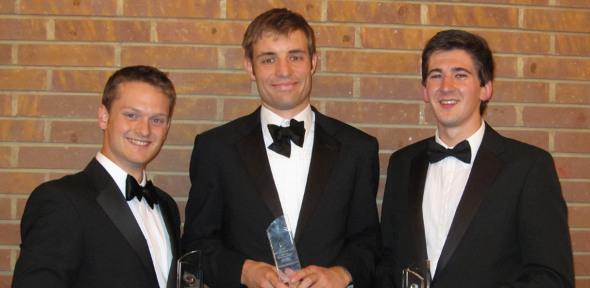
The SET Student of the Year Awards recognise outstanding achievement in science, engineering and technology by undergraduates at UK universities.
Record numbers of entries were received and judges paid tribute to the exceptional quality of this year’s work.
SET awards website
Three of last year's graduates were honoured at the Science, Engineering and Technology (SET) Awards: James Parker (Civil), Peter Whiteley (Mechanical) and Robert Woodward (Electronic).
James Parker won The Laing O’Rourke Award for the Best Civil Engineering Student, judged by The Institution of Civil Engineers (ICE), for his work on 'Construction Vibrations in the new Materials Science and Chemical Engineering Building at Cambridge', supervised by Allan McRobie, working with Ramboll Cambridge.
At the new Materials Science & Metallurgy building in West Cambridge, a suite of microscopes will provide a fascinating view onto materials at the nanoscale. These precision instruments require incredible control of ambient vibrations, but just after the new building opens, work will start on the new Chemical Engineering building next door. James' project predicted the effect that different construction equipment would have on the microscope suite, and his experiments included dropping a two tonne concrete weight to investigate the vibration-carrying properties of the soil and the huge two metre deep foundation which keeps the microscope suite so still.
Peter Whiteley won The Babcock Award for the Best Mechanical Engineering Student, judged by the Institution of Mechanical Engineers, for 'Fault detection in Wind-turbine Gearboxes', supervised by Dr Hugh Hunt.
The wind energy sector is expanding rapidly, with annual increases of over 30%; however its true potential is limited by recurrent expensive premature epicyclic gearbox failures, which primarily initiate in bearings. A mathematical model was developed by PhD student Mr Sharad Jain which used vibration analysis to identify bearing defects and the results of this model were confirmed experimentally through the design and testing of an experimental test rig. A variety of different bearing defects can be identified by their vibration characteristics and this information will now be used to develop effective fault detection algorithms to prevent catastrophic failures occurring. Peter and Sharad are presently preparing publications for international journals.
Robert Woodward won The ARM Award for the Best Electronic Engineering Student judged by the Institution of Engineering and Technology for his work on 'Novel Ultrafast Lasers Enabled by Nanotubes and Graphene', supervised by Professor Andrea Ferrari head of the Nanomaterials and Spectroscopy Group.
Ultrafast lasers produce ultrashort optical pulses which have a wide range of applications, including research, medicine and materials processing. Pulses are typically generated using a material called a saturable absorber. Graphene and carbon nanotubes have emerged as promising saturable absorbers, offering faster operation over greater wavelength ranges than semiconductor technologies which currently dominate. Robert's project investigated techniques to raise the output power of graphene and nanotube-based lasers. I reported the first demonstration of amplification of a graphene-based fibre laser, achieving the highest output power to date, which furthers the breadth of applications. He also demonstrated amplification of a nanotube-based laser and considered novel cavity configurations to simplify the system.
The awards were presented at a ceremony in Kensington Town Hall. More than 500 entries were received from over a hundred different universities.

